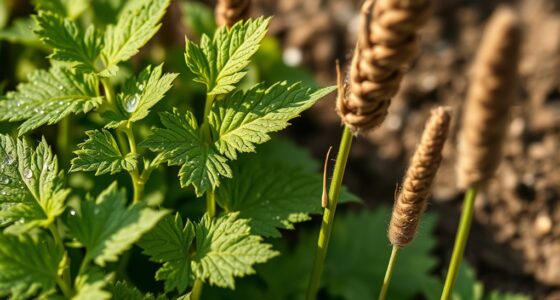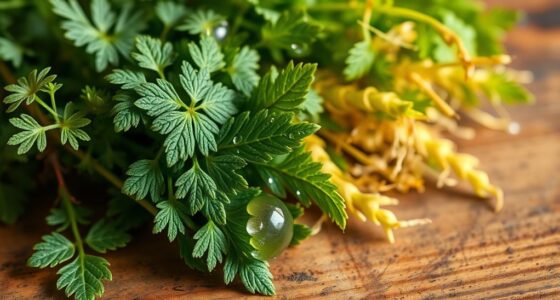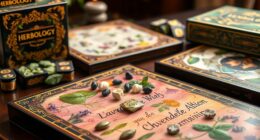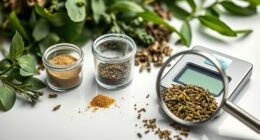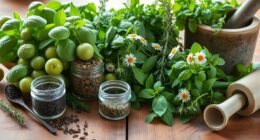Drynaria Rhizoma and Naringin work together to promote bone formation by boosting osteoblast activity and strengthening mineralization processes. Drynaria stimulates bone regeneration and enhances bone density, while Naringin from citrus fruits supports cell signaling pathways that encourage bone growth. Their combined effects activate key molecular pathways like Wnt/β-catenin and BMP, leading to stronger, healthier bones. To discover how these natural compounds can benefit your bone health, keep exploring more insights.
Key Takeaways
- Drynaria Rhizoma stimulates osteoblast activity, promotes mineralization, and enhances bone density for improved bone regeneration.
- Naringin, found in citrus fruits, supports osteoblast differentiation and inhibits osteoclast formation, balancing bone remodeling.
- Combining Drynaria Rhizoma with Naringin produces synergistic effects, amplifying osteogenesis and strengthening bone tissue.
- Both natural compounds activate molecular pathways like Wnt/β-catenin and BMP/Smad, promoting bone growth at the cellular level.
- Personalized treatment approaches considering genetic factors can optimize the bone-forming benefits of these herbal and phytochemical agents.
The Role of Osteoblasts in Bone Development
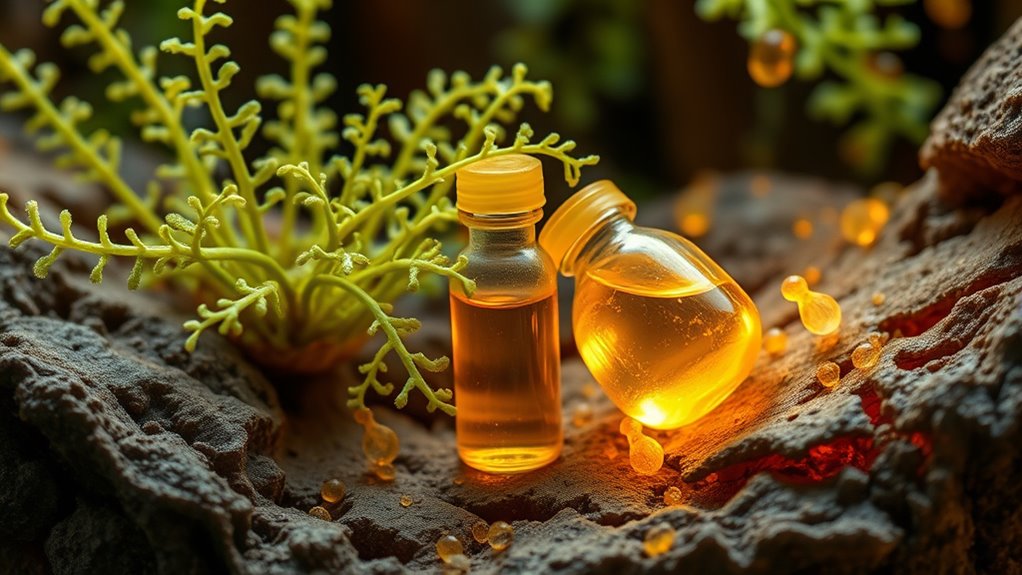
Osteoblasts play a crucial role in bone development by actively synthesizing and mineralizing the bone matrix. During osteoblast differentiation, precursor cells transform into mature osteoblasts capable of producing new bone tissue. These cells secrete collagen and other proteins essential for forming the organic component of the bone matrix. As they develop, osteoblasts deposit minerals like calcium phosphate, which harden the matrix and give bones their strength. Your body relies on this process for growth, repair, and maintaining bone density. Proper osteoblast function ensures healthy bone formation, preventing conditions like osteoporosis. Additionally, supporting osteoblast differentiation through proper nutrition and lifestyle choices can enhance overall bone health. By supporting osteoblast differentiation and promoting efficient bone matrix synthesis, you can positively influence your bone health and structural integrity. Healthy bone formation depends on the proper function of osteoblasts and the availability of nutrients necessary for mineralization.
Traditional Uses of Drynaria Rhizoma in Herbal Medicine

Drynaria Rhizoma, a traditional herbal remedy, has been widely used in Chinese medicine to promote bone health and treat skeletal disorders. You’ll find it commonly in herbal preparations aimed at strengthening bones and accelerating healing. Its use features in various traditional formulations designed to support recovery from fractures and osteoporosis. These formulations often combine Drynaria with other herbs to enhance efficacy. Recognizing the vetted safety and effectiveness of these herbal remedies is crucial for their proper application and benefits. Additionally, ongoing research continues to validate herbal treatments, ensuring their continued role in integrative medicine. The incorporation of Drynaria Rhizoma into modern treatment strategies highlights the importance of herbal medicine in complementing conventional therapies. Understanding the traditional applications of Drynaria Rhizoma can help guide its safe and effective use in contemporary practice.
Naringin’s Natural Sources and Bioavailability

Naringin is a naturally occurring flavonoid mainly found in citrus fruits, such as grapefruits, oranges, and pomelos. To obtain it, herbal extraction methods are commonly used, allowing you to concentrate its beneficial properties. However, its bioavailability can be limited due to factors like poor solubility and intestinal metabolism. These bioavailability factors influence how much naringin your body can effectively absorb and utilize. To improve absorption, formulations such as nanoemulsions or complexation with other compounds are often employed. Understanding these aspects helps you maximize naringin’s health benefits, especially its role in supporting bone health. Proper extraction techniques combined with strategies to enhance bioavailability ensure you get the most out of this potent flavonoid.
How Drynaria Rhizoma Promotes Bone Regeneration

Drynaria Rhizoma actively stimulates osteoblast activity, encouraging new bone formation. It also enhances bone density, making bones stronger and more resistant to fractures. Additionally, it promotes mineralization processes essential for healthy, regenerative bone tissue. Incorporating mineralization processes can further optimize the effects of Drynaria Rhizoma on bone health. The herb’s ability to support bone regeneration is a key factor in its therapeutic potential. Proper safety precautions should be observed when using herbal supplements to ensure effective and safe treatment. Understanding natural materials used in traditional remedies can provide deeper insights into their mechanisms of action.
Stimulates Osteoblast Activity
Research shows that compounds found in Drynaria Rhizoma can directly enhance osteoblast activity, which is essential for bone formation. By stimulating these cells, you promote increased collagen synthesis, a critical component of the bone matrix. As osteoblasts become more active, they produce more collagen, strengthening the bone structure and improving overall bone strength. This process supports the development of new bone tissue and helps repair existing damage. The bioactive compounds in Drynaria Rhizoma target osteoblasts, encouraging their proliferation and function. Additionally, supportive factors such as growth factors can further enhance osteoblast activity, leading to more effective bone regeneration. These factors are influenced by signaling pathways that regulate osteoblast differentiation and activity. Furthermore, understanding the refined properties of Drynaria Rhizoma can optimize its use in therapeutic applications. As a result, you benefit from a more robust, resilient skeletal system. This stimulation of osteoblast activity not only accelerates bone regeneration but also lays the groundwork for long-term bone health and durability.
Enhances Bone Density
By promoting osteoblast activity, Drynaria Rhizoma markedly contributes to increased bone density. Its traditional efficacy stems from herbal synergy that enhances bone regeneration. You’ll notice that this herbal combination supports the body’s natural processes, leading to stronger bones over time. The synergy between Drynaria Rhizoma and other herbs amplifies its effects, making it a valued remedy in traditional medicine. This synergy not only boosts osteoblast function but also helps maintain structural integrity. To visualize, consider the following:
| Benefit | Explanation |
|---|---|
| Increased Bone Density | Results from enhanced osteoblast activity |
| Herbal Synergy | Amplifies traditional efficacy |
| Bone Strength | Achieved through improved density |
| Long-term Support | Maintains bone health over time |
This approach makes Drynaria Rhizoma a potent natural option for promoting stronger bones. Additionally, understanding the herbal synergy involved can lead to more effective use of traditional remedies. Recognizing the importance of osteoblast activity can further optimize bone health strategies.
Promotes Mineralization Processes
Drynaria Rhizoma actively promotes mineralization by stimulating the deposition of calcium and phosphate into the bone matrix. It enhances mineralization signaling pathways, which are vital for activating osteoblasts and accelerating matrix mineral deposition. This process strengthens the bone structure, making it more resilient. By boosting mineralization, Drynaria Rhizoma guarantees that the bone matrix becomes properly mineralized, leading to improved bone density and integrity. Its bioactive compounds support the intricate steps of mineralization signaling, guaranteeing efficient calcium and phosphate integration. As a result, you experience faster and more effective bone regeneration, ultimately restoring bone strength and reducing fracture risks. This natural approach targets the core of bone mineralization, making Drynaria Rhizoma a valuable ally in bone health management.
Naringin’s Influence on Bone Cell Activity
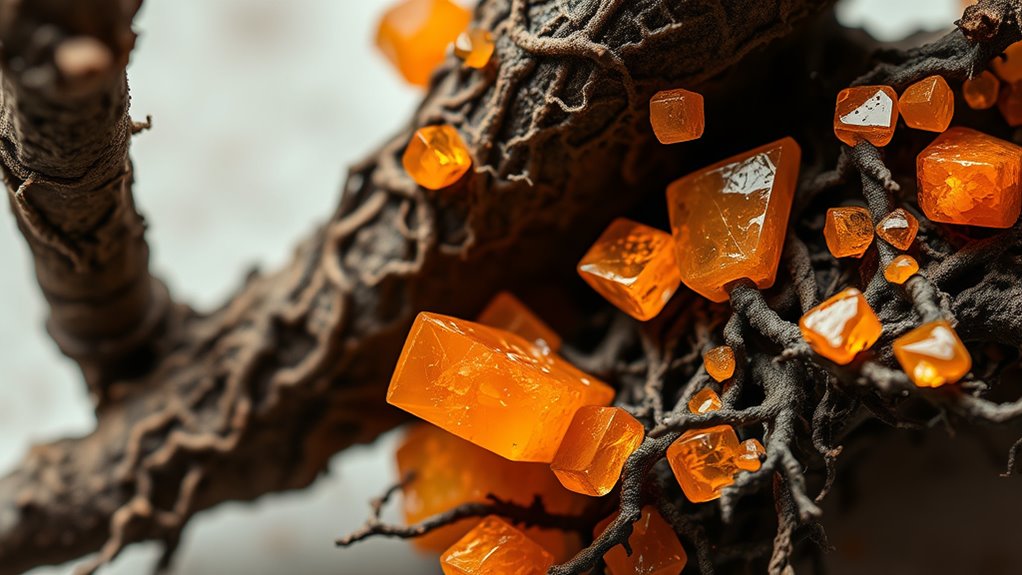
Have you ever wondered how naringin influences bone cell activity? It plays a crucial role in bone remodeling by modulating osteocyte signaling, which governs the communication between bone cells. Naringin encourages osteoblast activity while inhibiting osteoclast formation, balancing bone formation and resorption. This dual action helps maintain healthy bone density. Moreover, understanding the cellular mechanisms involved can lead to better therapeutic strategies for bone-related conditions. Maintaining a balanced bone remodeling process is essential for overall skeletal health and can be supported through targeted interventions. Additionally, insights from data privacy challenges highlight the importance of ethical considerations in developing new treatments.
Synergistic Effects of Drynaria Rhizoma and Naringin on Osteogenesis
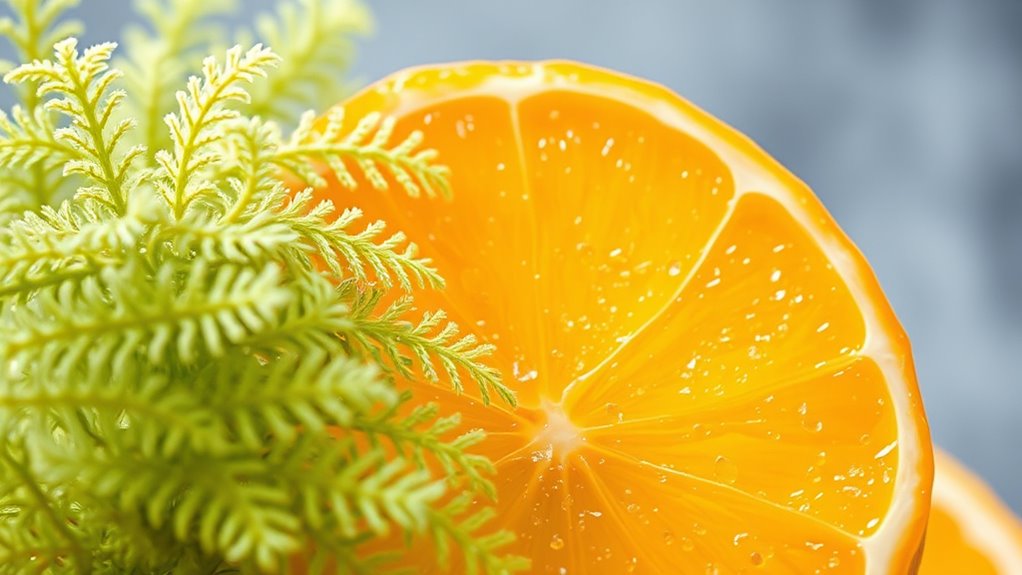
Recent research highlights how combining Drynaria Rhizoma with naringin produces a synergistic effect that markedly enhances osteogenesis. This herbal synergy results from their complementary actions in promoting bone formation, making plant extraction a powerful approach in natural therapies. When used together, these compounds amplify each other’s benefits, leading to increased osteoblast activity and mineralization. The combination enhances key processes involved in bone regeneration more effectively than either alone. By integrating Drynaria Rhizoma and naringin, you leverage their distinct bioactive properties, creating a potent formula for bone health. This synergy underscores the potential of plant-based extracts in developing advanced osteogenic treatments, offering a promising natural strategy for improving bone density and preventing conditions like osteoporosis.
Molecular Pathways Activated by These Natural Compounds
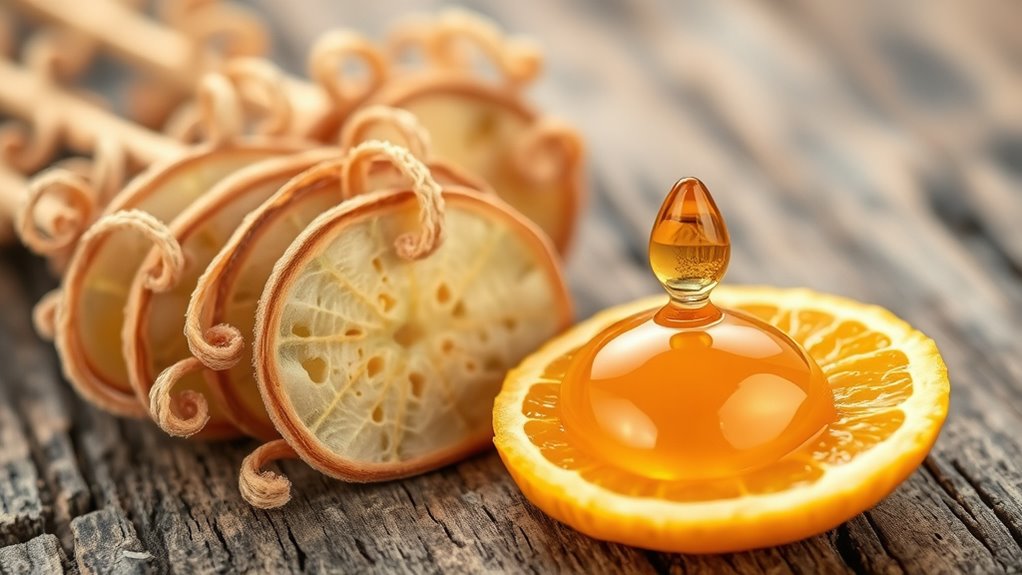
The enhanced osteogenic effects observed when combining Drynaria Rhizoma and naringin are driven by their activation of specific molecular pathways that regulate bone formation. These compounds influence genetic regulation by upregulating genes involved in osteogenesis, such as Runx2 and Osterix, essential for osteoblast differentiation. They also modulate signal transduction pathways like BMP/Smad and Wnt/β-catenin, which are vital for bone growth. Understanding these pathways reveals how targeted activation boosts bone matrix production and mineralization. Additionally, the activation of cell signaling pathways promotes the proliferation and maturation of bone-forming cells. This targeted activation boosts bone matrix production and mineralization. Exploring the bone remodeling process helps elucidate how these compounds contribute to maintaining skeletal integrity and repair. Understanding these molecular mechanisms helps clarify how natural compounds can effectively stimulate bone regeneration, providing a foundation for developing new osteogenic therapies based on these bioactive substances.
Evidence From Laboratory and Animal Studies
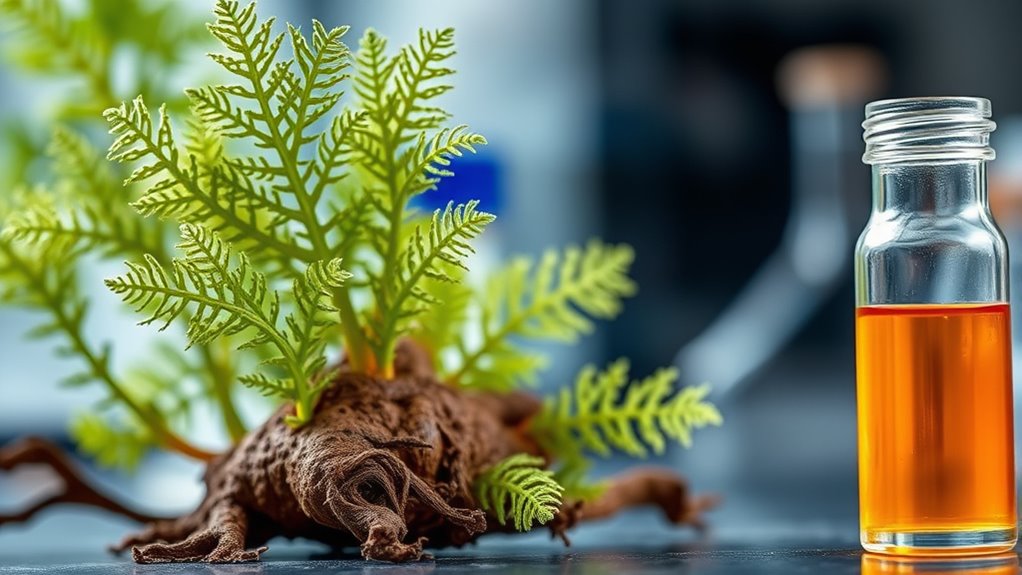
Laboratory and animal studies show that Drynaria Rhizoma and Naringin can boost bone density and promote cellular bone growth. You’ll find evidence indicating improved bone strength and structure in various animal models. These results suggest promising potential for further research into their bone-healing properties.
Bone Density Improvement
Studies consistently show that Drynaria Rhizoma and Naringin can boost bone density, as evidenced by laboratory and animal research. These compounds improve bone strength through mechanisms influenced by nutritional factors and genetic influences. You’ll find that their effects vary depending on dietary calcium, vitamin D levels, and genetic predispositions. The table below highlights key findings:
| Study Type | Main Outcome | Influencing Factors |
|---|---|---|
| Laboratory | Increased bone mass | Nutritional status, genetics |
| Animal | Improved bone density | Diet, genetic background |
| Laboratory | Enhanced mineralization | Nutritional intake |
| Animal | Reduced bone loss | Genetic factors |
| Laboratory | Strengthened bones | Nutritional and genetic factors |
These studies confirm that bone density improvements are multifactorial, with nutrition and genetics playing vital roles.
Cellular Bone Growth
How exactly do Drynaria Rhizoma and Naringin promote cellular bone growth? Laboratory and animal studies show they stimulate bone marrow-derived stem cells to differentiate into osteoblasts, increasing bone formation. These compounds enhance the proliferation and activity of osteogenic cells, supporting new bone tissue development. They also facilitate cartilage repair, which is essential for maintaining healthy bone growth and healing fractures. By boosting cellular activity within the bone marrow, they help generate a robust pool of precursors ready to form new bone. This process not only strengthens existing bone but also promotes regeneration in damaged areas. Overall, Drynaria Rhizoma and Naringin directly influence cellular mechanisms vital for effective bone regeneration and repair, as evidenced by laboratory and animal research.
Animal Model Results
Animal model research provides compelling evidence that Drynaria Rhizoma and Naringin effectively promote bone regeneration. These studies reveal herbal synergy, where combined phytochemicals enhance osteogenic outcomes beyond individual effects. The phytochemical mechanisms involve stimulating osteoblast activity, increasing mineralization, and reducing osteoclast-mediated bone resorption. In rodent models of osteoporosis and bone defects, treatments with Drynaria Rhizoma and Naringin markedly improved bone density and biomechanical strength. These findings support their potential as natural therapeutic agents. The animal studies demonstrate that the bioactive compounds modulate signaling pathways critical for bone formation, confirming their ability to facilitate healing and regeneration. Overall, the evidence from laboratory and animal models underscores the promising role of these phytochemicals in bone health.
Potential Benefits and Limitations for Human Bone Health
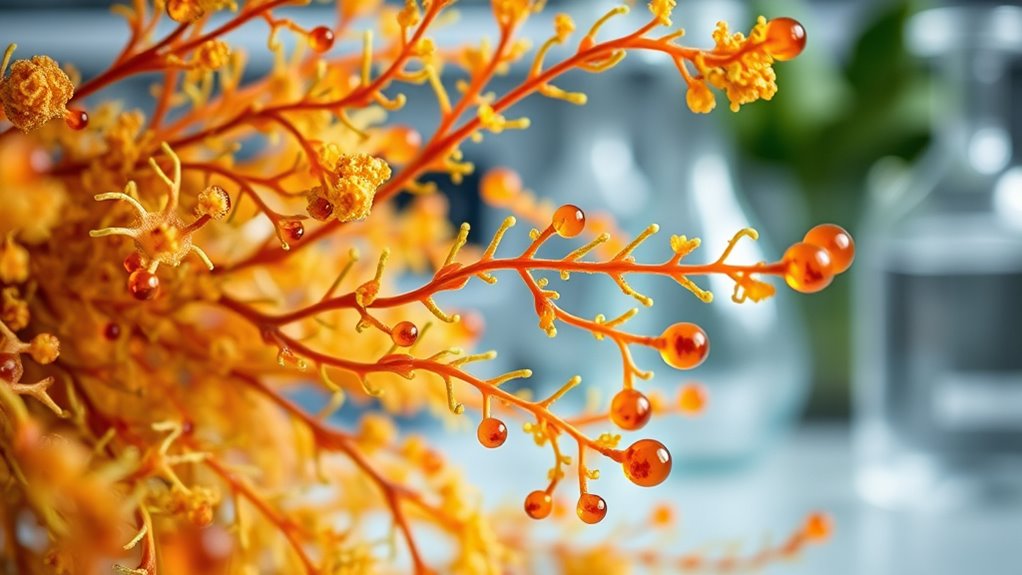
Drynaria Rhizoma and Naringin show promise for supporting human bone health by promoting bone formation and reducing bone resorption. Their potential benefits stem from herbal synergy and traditional knowledge, which guide their use in natural therapies. However, limitations exist. First, clinical studies are limited, making it hard to confirm safety and efficacy. Second, individual responses vary, and dosage optimization remains unclear. Third, potential interactions with medications could pose risks. Fourth, long-term effects are not well-understood. While these natural compounds offer exciting possibilities, you should approach them with caution. Their use should complement, not replace, conventional treatments. Recognizing both benefits and constraints helps you make informed decisions about integrating these herbal options into your bone health strategy.
Future Directions in Natural Bone-Enhancing Therapies
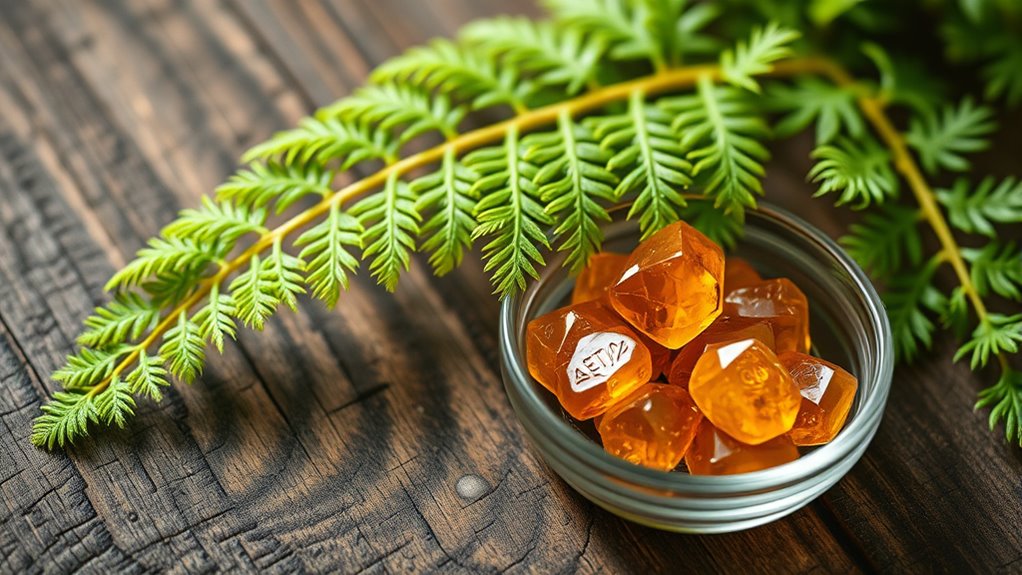
Advances in research are shaping the future of natural therapies for bone health, focusing on optimizing efficacy and safety. You’ll see efforts to personalize treatments by considering genetic factors that influence individual responses to compounds like Drynaria Rhizoma and Naringin. Understanding genetic variations helps identify who benefits most from these therapies and minimizes adverse effects. Nutritional influences also play an essential role, as diet impacts the body’s absorption and utilization of these natural agents. Future strategies aim to integrate genetic screening and nutritional assessments to create tailored, effective bone-enhancing approaches. This personalized approach could maximize benefits, reduce risks, and pave the way for more targeted, safe, and sustainable natural therapies for bone health.
Frequently Asked Questions
Are There Any Known Side Effects of Drynaria Rhizoma or Naringin?
You should be aware that drynaria rhizoma and naringin can cause allergic reactions in some people, including skin rashes or breathing difficulties. Additionally, they might lead to gastrointestinal issues like nausea, stomach pain, or diarrhea. If you notice any of these side effects, it is crucial to stop using them and consult a healthcare professional. Always follow recommended dosages and discuss with your doctor before starting new herbal supplements.
How Do Drynaria Rhizoma and Naringin Interact With Common Osteoporosis Medications?
Think of your medications as a symphony—adding Drynaria Rhizoma and Naringin could enhance their harmony through synergistic effects. These compounds may interact with common osteoporosis medications, potentially boosting bone health. However, you should be cautious, as drug interactions might alter effectiveness or cause side effects. Always consult your healthcare provider before combining these supplements with your prescribed treatments to guarantee safety and ideal results.
What Are Optimal Dosages for These Compounds in Humans?
You should follow dosage guidelines based on current research and clinical trials to guarantee safety and effectiveness. For Drynaria Rhizoma, typical therapeutic ranges are around 300-600 mg daily, but consult a healthcare professional for personalized advice. Naringin dosages vary, often 100-200 mg daily, yet individual needs may differ. Always prioritize professional guidance to determine ideal dosages, avoiding potential interactions and side effects.
Can These Natural Compounds Prevent Bone Loss in Aging Populations?
Yes, these natural compounds can help prevent bone loss in aging populations when used as part of dietary supplementation strategies. You should consider herbal supplement interactions to guarantee safety and effectiveness. Incorporate them thoughtfully into your routine, following recommended dosages and consulting healthcare providers. This approach can support bone health, but individual responses vary, so ongoing monitoring and personalized strategies are key to maximizing benefits.
Are There Ongoing Clinical Trials Testing These Substances for Bone Health?
Yes, ongoing clinical trials are exploring these compounds for bone health. You should know that the trial designs are carefully crafted to assess safety and efficacy, maneuvering complex regulatory approval processes. These studies could be pivotal in transforming natural remedies into mainstream treatments. Keep an eye on updates, because if promising results emerge, you might soon benefit from innovative, plant-based solutions for stronger bones.
Conclusion
By exploring how Drynaria Rhizoma and naringin boost bone formation, you see the potential for natural remedies to rival ancient healing arts. These compounds activate key molecular pathways, helping your bones stay strong and healthy—like a trusty knight defending a castle. While more research is needed, incorporating these natural options today could be your modern-day “Holy Grail” for bone health, bridging the wisdom of old with science’s promise for tomorrow.




